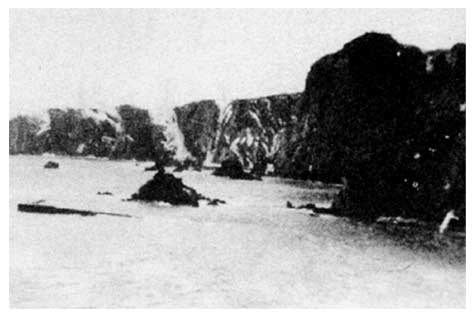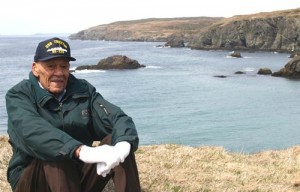A shipwreck, a tiny town on Newfoundland’s Burin Peninsula and the seeds of the U.S. civil rights movement would seem to be an unusual juxtaposition. It happened way back in 1942 but had ramifications right down to present times.
On February 18, 1942 a raging winter st orm, strict war-time radio silence and a course miscalculation resulted in the wreck of American war ships U.S.S. Truxtun and U.S.S. Pollux. Smashing into the 300-foot cliffs of Chamber Cove at Newfoundland’s Burin Peninsula both vessels quickly submerged in the freezing North Atlantic waters.
orm, strict war-time radio silence and a course miscalculation resulted in the wreck of American war ships U.S.S. Truxtun and U.S.S. Pollux. Smashing into the 300-foot cliffs of Chamber Cove at Newfoundland’s Burin Peninsula both vessels quickly submerged in the freezing North Atlantic waters.
Despite apparently hopeless conditions, 186 of the 389 seamen on the two vessels were saved thanks to the heroic efforts of the residents of the nearby mining community of St. Lawrence.
As the Truxtun sank into the sea, a group comprised of Lanier Phillips and four other black men held a frantic discussion aboard the Truxtun. They were all mess hands because in 1942 Americans of African origin were only allowed to work in the ship’s kitchen. Many ports refused to even allow the black seamen ashore, and the topic of discussion among them was whether it would be better to go down with the ship or risk being lynched or worse if they ventured ashore.
 This was no idle concern for Lanier Phillips of Dekalb County, Georgia — the Ku Klux Klan, lynchings and prejudice were a regular part of life in his home community. Throwing caution to the wind, he managed to make his way through oil-slick waters to the beach where he collapsed and readied himself to die.
This was no idle concern for Lanier Phillips of Dekalb County, Georgia — the Ku Klux Klan, lynchings and prejudice were a regular part of life in his home community. Throwing caution to the wind, he managed to make his way through oil-slick waters to the beach where he collapsed and readied himself to die.
Several white Newfoundlanders came by and Phillips prepared himself to be kicked aside as they looked for Caucasian survivors. Surprisingly he was brought to his feet, hauled up the cliff and soon found himself in the dry house of the Springs Mine where two women attempted to scrub what they thought was oil off of his unclothed body. “This poor fellow’s got the oil soaked right into his pores,” said one. Having never seen a black man before, his rescuer was in danger of taking off Phillips’ skin! Her friend quickly corrected her error.
 Phillips was convinced he was in for it now. The Klan would have lynched any naked black man within 100 yards of a white woman.
Phillips was convinced he was in for it now. The Klan would have lynched any naked black man within 100 yards of a white woman.
Instead, the woman who almost scrubbed his skin off, insisted he be brought to her house where he was nursed back to health and treated as an equal.
The experience was to have a profound effect on Lanier Phillips. After he returned to the South, he was out in uniform one day and looking for a place to have lunch. He saw a restaurant where German P.O.W.’s were eating and tried to enter. A policeman threw him to the floor and put his foot on Lanier’s throat. Pulling out his pistol he forbade a uniformed American the right to eat in the same restaurant as German prisoners.
Phillips had had enough. He wrote to the sole U.S. black congressman and asked for the right to do something in the navy besides preparing food for white people. He was accepted to the U.S. Navy’s Sonar School, and he became the Navy’s first African-American sonar technician. He marched alongside Martin Luther King in Selma, Alabama in March, 1965 and became an outspoken supporter of equal rights for blacks.
He was later honored by Newfoundland’s Memorial University with an Honourary Doctorate of Law degree.
Lanier Phillips never forgot the people of St. Lawrence, Newfoundland — a simple people who gave him his human dignity and confirmed his right to the level of respect due to any human being. When the Springs Mine closed, the town fell on hard times. Though not a wealthy man, Phillips scraped and saved money and returned to the town of St. Lawrence where he funded a new playground for the town’s elementary school. Appropriately, the playground was name for its benefactor.
Videos to Watch…
Photo Credits
Photos of the U.S.S. Truxtun courtesy of The Survivor website.
Photo of Lanier Phillips, courtesy of The Southern Gazette


The ship’s name is TRUXTUN NOT REPEAT NOT truxton.
You would be surprised how many times that mistake is made even by people who should know better..Our cadet corp here in Lawn is RCSCC Truxtun and the bell from their namesake the USS Truxtun is part of their display..Our group the Memorial Trail Of Heroes focuses on the men from our community who made the long trek by horse and sled to the site of the wreck of the USS Pollux which I might add wasn’t at Chamber Cove.If you would like to know more pop by our Facebook group..https://www.facebook.com/groups/750690935040993/
Hi Willis,
Thanks for the correction. We have updated the spelling and George Burden thanks you for letting us know.
Cheers,
Gil
Thanks for your correction…And I might also like to add there was another African America saved that day from the USS Pollux which grounded on Lawn Point near our community of Lawn..That sailors name was Leon Dawson and he was still in the US Navy as a chief steward in 1946.
I would just like to mention an error in this story,only one ship ran aground at Chambers Cove.The other ship was grounded at Lawn Point,NL many miles away.Fishermen from Lawn drove to the site of the wreck during a vicious snowstorm,they drove by horse & sled into unknown ground.These men were responsible for saving 137 sailors from the USS Pollux…These men are our heroes.
Does anyone know the names of the men from Lawn.
Men from Lawn were,James Manning..Joseph Manning..Martin Edwards…James Drake..Robert Jarvis..Andrew Edwards…There was a party of 10 men at first Frederick Edwards and Clarence Manning had to turn back due to illness..None of these men were prepared for this journey,they went with axes,rope and little or no food for themselves nor their horses,no dry clothing and the communities of St Lawrence and Lawn were 3-5 hrs away,so they made do with what they had & 137 men from the USS Pollux owe their lives to hardy Newfoundland men.
Is there a record of the Men and Women from St Lawrence who participated in the rescue. I have a lot of family from there and wondering if I recognize the names. Although my parents were born in the thirties I never heard a word about the unbelievable rescue until a couple of years ago. My Dad was from St. Lawrence and my Mom born in Lord’s Cove then moved to Lawn.
It is such a Heroic effort on the part of the NFLD people to risk themselves to save people in need. And the province is still a good place as evidenced in the sacrifices they made to aid the passengers that were grounded in Gander on 911. Its nice to be connected to that through family and it makes me really proud of the place my Dad came from.
Gary
Hi Gary,you might be able to contact the St Lawrence Historical Board for the names of the men from St Lawrence,there were also men from Lawn,Lord’s Cove,Epworth and other towns around on the peninsula who worked at the mines and helped with the rescues. They have a Facebook group at https://www.facebook.com/groups/807934779234691/
Every story I read about the disaster, all that is mention is St. Lawrence , what about the people of Lawn, they too saved people from the uss pollux. and there were lawners that worked in the mines, that were there as well, after all these years and no one tells the whole story and how lawn was involved.
This is such a remarkable story of human tragedy. I am reading a book from my library about the ship wrecks and curious to learn more about what took place that horrible day. Thank you for the information you posted and especially the video from one of the survirors.
You can join our group and find info about the USS Pollux..https://www.facebook.com/groups/750690935040993/
My grandmother’s brother was on the USS Truxton and survived. His name was Edward Perry. Uncle Eddie to me.
Gram told me that she woke up suddenly, early that morning on February 18, 1942. She said she ran into her father’s room and said to him “Something has happened to Eddie. I can feel it.” Sure enough they got word of the shipwreck. She said she doesn’t know why but something just came over her, that told her he was in trouble of some kind.
I was told that the oil was so thick, the area was quite rocky and everything was very very slick the day of that shipwreck. The oil was dragging the sailors down. The smell of the oil was gagging the sailors. Eddie told my grandmother that he was going under when someone reached out and grabbed his miraculous medal that he wore around his neck and pulled him to safety, whatever “safety” meant, whether it meant he was kept above water from drowning or pulled onto a rock but the chain held and he was saved.
My grandmother had a book that was written about the Truxton shipwreck. His two children have copies, too. I gave Gram’s copy to them as well when she passed.
Eddie got married and his wife, Elinor, was my godmother. She passed away several years ago. Uncle Eddie recently passed away at age 89.5 years old on Thursday, March 17, 2011 in Plymouth, MA.
Elinor told my grandmother that Eddie would never speak of the tragedy but she knew the memories of that day haunted him during his sleep for the rest of his life.
Uncle Eddie’s obituary states that he was a decorated WWII US Navy veteran who served with distinction in both the European and Asiatic-Pacific theaters.
Uncle Eddie suffered from Alzheimer’s Disease as did his sister and my mother.
Eddie has two grown children (my cousins) who are doing well and have their own families now. They have been told about this historical event and have the books to pass on to their children about our family navy veteran who served, went through the hardships of war, the horror of war operations and was someone lucky and greatful to have survived.
What a wonderful story. Thank you for sharing it with me.
What a wonderful story!
Thanks,
I’m glad you enjoyed it!